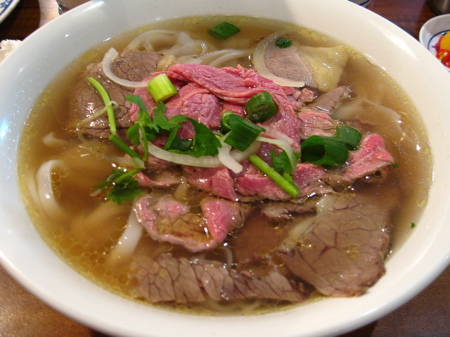A bowl of fiery noodle soup might not be everyone’s idea of typical summer fare, but that’s what you can expect to find on the majority of Vietnamese breakfast tables right now, during the dry season. The logic here also explains why ice cream is so popular in Russia – if you feel cold on the inside, you won’t then notice how cold it is outside. So spices and hot teas are often consumed in tropical climates to cool you down.
Pho is the classic Vietnamese noodle soup - a seemingly simple concoction of beef, broth and white rice noodles. The dish is over a century old, with origins in both Chinese and French cuisine , and the name ‘pho’ is believed to be derived from pot au feu - a French soup.
The most difficult part to get right is the broth: beef bones are boiled on a low heat over several hours alongside oxtails and onions, and are typically seasoned with star anise, salt and pepper. I have seen many unique and subtle twists taken on this formula, including adding cinnamon, cloves, cardamom and other eastern spices as embellishments.
Having lived in Ho Chi Minh City for the past four years, I’ve had my fair share of steaming bowlfuls of pho, from soulless chain restaurants to family-run food stalls, and have picked up some great tips from locals on what makes the perfect bowlful.
What makes the dish uniquely Vietnamese is how the diner can customize it. This includes choosing which cuts of meat to have. One of the most satisfying options is known locally as tai chin, where both pre-cooked flank and raw slices of steak are added, the latter of which cooks in the boiling broth at the table.
This dish should arrive garnished with sliced white onions, a whole spring onion and a liberal sprinkling of black pepper. Vietnam is now the world’s largest producer and exporter of peppercorns, and one of the most interesting varieties in terms of delicacy and nuance originates from Phu Quoc, a tiny island of the southwest coast. In the north of Vietnam, they garnish pho with thinly sliced ginger, which provides a different piquancy to the broth that won’t be to everyone’s taste.

Once the bowl is brought to the table, the fun of modification really begins. Tables in pho restaurants are always piled high with condiments and herbs. Here are my tips for the perfect way to tweak the dish for maximum flavor.
Start with the herbs. Tear up a few leaves of fresh basil and Vietnamese mint and stir into the bowl. Squeeze a quarter of lime into the broth and add a few slices of fresh chilli and a handful of dry bean sprouts, which will engender a lovely bite. Next, take a small dipping bowl and fill with hoisin sauce and a spoonful of Vietnamese saté – crushed red chilli flakes, garlic and oil.
Local Vietnamese would then pick up a choice chunk of beef and noodles between their chopsticks, coat it in the dipping bowl mixture, re-dip it in the broth, and devour. This creates a complex, spice-fueled mouthful that is exquisitely intense.
Whatever your take on this Vietnamese staple, the essential thing is to serve it piping hot and to provide all the necessary tabletop supplements, so the customer can make it uniquely theirs.